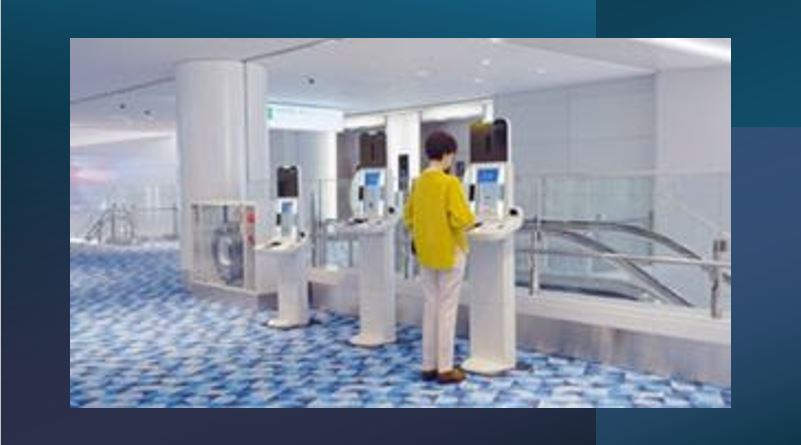The solution will contribute to reducing airport congestion at Haneda Airport by optimizing procedures thanks to facial recognition technology

THE NEC received a request from the Japan Immigration and Customs Services Agency for the installation of totems or KIOSKs, which have facial identification and will be used for immigration and customs inspections, in order to facilitate procedures, without interruptions, in Terminal 2 of the Haneda Airport in Tokyo.
The first field tests for these KIOSKs began on January 31, 2024. By recording the necessary information in advance using the first KIOSK deployed along the airport entry route and linking the information from systems used by the Immigration and Customs Enforcement Agency in Japan, procedures are now analyzed in a single location, which contributed to arrival procedures occurring without interruptions and with less congestion at the airport terminal.
Immigration and Customs Declaration KIOSk
With the increase in the number of foreign visitors to Japan, many airport users have begun to carry out immigration and customs procedures electronically. Furthermore, with the Japanese government setting a target of welcoming more than 60 million foreign visitors by 2030, it is vital to ensure smooth and efficient procedures at airports, making electronic tools receive increasing attention.
Using NeoFace, the core technology of NEC's Bio-IDiom portfolio (*1), with biometric authentication, artificial intelligence engine and facial recognition, evaluated in tests as the most accurate in the world (*2), these KIOSKS can be used to verify the identity of travelers. Thus, with the help of a suitable camera that is automatically selected, it is capable of identifying the user's height, allowing quick recognition, regardless of whether the user is in a wheelchair, for example.
NeoFace can also automatically detect masks, sunglasses and other accessories, issuing an alert so that only requested people can remove them. Therefore, the number of steps required to take photographs suitable for immigration procedures is minimized. By utilizing the fingerprint identification technology that NEC has developed over the years, it is possible to scan fingerprints at higher speeds without compromising matching accuracy, thus ensuring a smoother identity verification process.
- Highly reliable identity verification using facial recognition and fingerprint identification technology
With the increase in the number of foreign visitors to Japan, many airport users began to carry out immigration and customs procedures electronically. Furthermore, with the Japanese government having set a target of welcoming more than 60 million foreign visitors by 2030, it is vital to ensure more efficient and less invasive procedures at airports, resulting in electronic tools receiving increasing attention.
These KIOSKs are powered by NeoFace, the core technology in NEC's Bio-IDiom (*1) portfolio, which features biometric authentication, an artificial intelligence engine and facial recognition, rated in testing as the most accurate in the world (*2). These frameworks can be used to reliably verify the identity of travelers. Furthermore, with the help of an appropriate and automatically selected camera, it is capable of identifying the user's height, which means that recognition can be carried out quickly, regardless of whether the traveler is using a wheelchair, for example.
NeoFace can also automatically detect masks, sunglasses or other accessories, issuing an alert so that only the requested people remove these items, minimizing the number of steps required to take photographs suitable for immigration procedures.
Additionally, by utilizing the fingerprint identification technology that NEC has developed over the years, it becomes possible to scan fingerprints at higher speeds without compromising matching accuracy and ensuring a smoother identity verification process.
- Screen design with a high degree of usability and multiple support systems
The new system also works to identify the appropriate language. It is automatically displayed when the user scans their QR Code for entry records and customs declaration information in KIOSK, which eliminates the inconvenience of the passenger having to make the change manually.
The design is completely user-centered, making elaborate illustrations and color schemes appear on the screen to help first-time tourists follow instructions more easily. You can also check support functions to provide operational assistance through animation and sound guidance when needed so that users can complete procedures stress-free.
NEC is committed to providing the safest and most convenient arrival and departure services around the world.
Grades
(*1) “Bio-IDiom” is NEC's portfolio of biometric identification solutions, including face, iris, fingerprint, palm, finger vein, voice and ear acoustics solutions. https://www.nec.com/en/global/
(*2) NEC has repeatedly ranked first as the world's most accurate facial recognition technology in vendor testing conducted by the US National Institute of Standards and Technology (NIST). Assessment results do not represent U.S. government recommendations for specific products.












